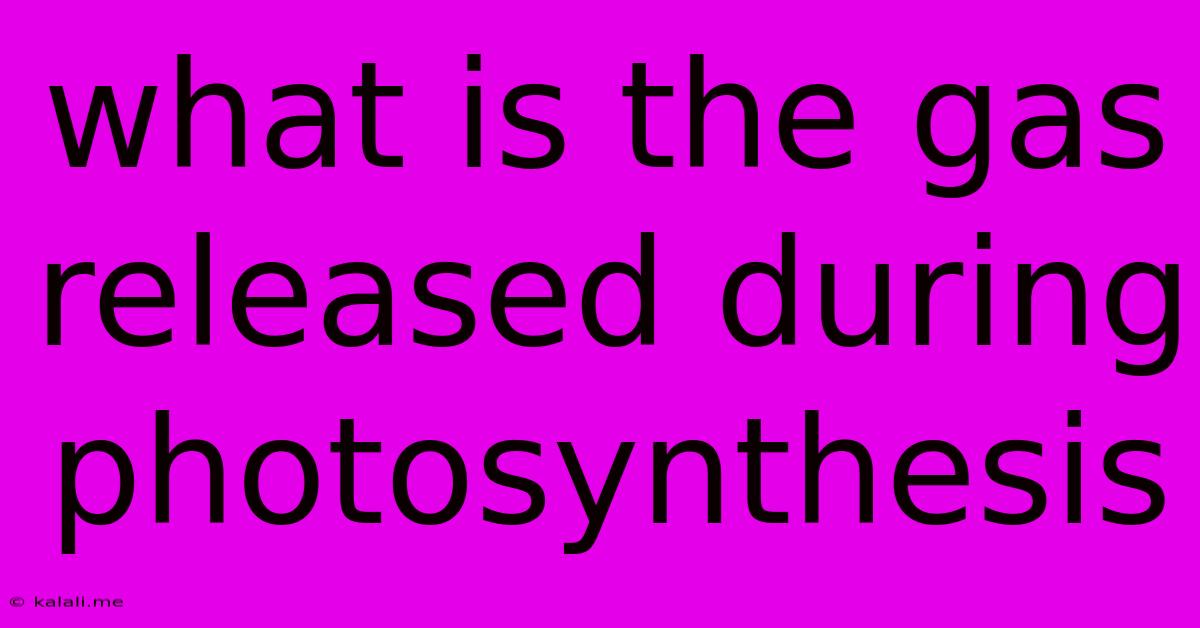What Is The Gas Released During Photosynthesis
Kalali
Jun 15, 2025 · 3 min read

Table of Contents
What is the Gas Released During Photosynthesis?
Photosynthesis, the remarkable process by which plants and other organisms convert light energy into chemical energy, is crucial for life on Earth. But what exactly is released during this vital process? The primary gas released during photosynthesis is oxygen (O2). This oxygen is a byproduct of the splitting of water molecules (photolysis) within the chloroplasts of plant cells. Understanding this process is key to appreciating the fundamental role plants play in maintaining our atmosphere.
The Process of Photosynthesis and Oxygen Production
Photosynthesis occurs in two main stages: the light-dependent reactions and the light-independent reactions (also known as the Calvin cycle). It's during the light-dependent reactions that oxygen is produced. This stage takes place in the thylakoid membranes within chloroplasts. Here's a simplified breakdown:
- Light Absorption: Chlorophyll and other pigments within the chloroplasts absorb light energy.
- Water Splitting (Photolysis): The absorbed light energy is used to split water molecules (H₂O) into oxygen (O₂), hydrogen ions (H+), and electrons.
- Electron Transport Chain: The electrons released from water move through a series of protein complexes, creating a proton gradient.
- ATP and NADPH Synthesis: This proton gradient drives the synthesis of ATP (adenosine triphosphate) and NADPH, which are energy-carrying molecules.
- Oxygen Release: The oxygen produced during water splitting is released into the atmosphere as a byproduct.
The light-independent reactions, on the other hand, use the ATP and NADPH generated in the light-dependent reactions to convert carbon dioxide (CO2) into glucose (C6H12O6), a sugar molecule that serves as the plant's energy source. This stage doesn't directly release oxygen.
The Significance of Oxygen Release
The release of oxygen during photosynthesis has profound implications for life on Earth. Early photosynthetic organisms, cyanobacteria, are credited with releasing vast quantities of oxygen into the atmosphere billions of years ago, transforming Earth's atmosphere from an oxygen-poor environment to one suitable for the evolution of aerobic organisms, including humans.
Today, photosynthesis continues to be the primary source of oxygen in our atmosphere, maintaining the balance of gases essential for the survival of countless species. Deforestation and other environmental factors that reduce plant life threaten this crucial process, highlighting the importance of preserving our planet's plant cover.
Other Gases Involved in Photosynthesis
While oxygen is the primary gas released, it's important to remember that photosynthesis also involves other gases. Carbon dioxide (CO2) is a key reactant, absorbed from the atmosphere during the light-independent reactions. Water vapor (H₂O) is also involved, both as a reactant and a product of some of the reactions within the chloroplast.
Understanding the intricacies of photosynthesis, including the release of oxygen and the role of other gases, is fundamental to appreciating the interconnectedness of life on Earth and the importance of environmental conservation. The seemingly simple process of plants producing oxygen is actually a complex and remarkably efficient system vital to the health of our planet.
Latest Posts
Latest Posts
-
Which Of The Following Is Not A Strong Base
Jun 16, 2025
-
The Atomic Number Is Determined By The Number Of
Jun 16, 2025
-
Normal Profit Is Also Known As Economic Profit
Jun 16, 2025
-
What Is A Factor Of 50
Jun 16, 2025
-
What Is The First Five Multiples Of 9
Jun 16, 2025
Related Post
Thank you for visiting our website which covers about What Is The Gas Released During Photosynthesis . We hope the information provided has been useful to you. Feel free to contact us if you have any questions or need further assistance. See you next time and don't miss to bookmark.